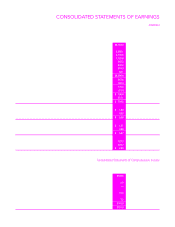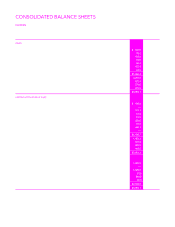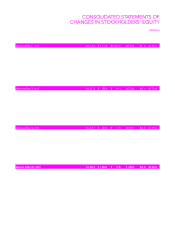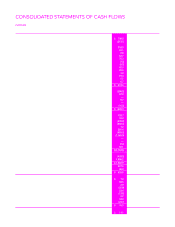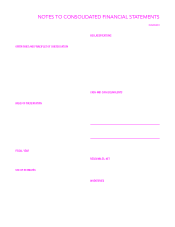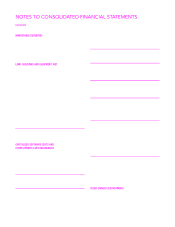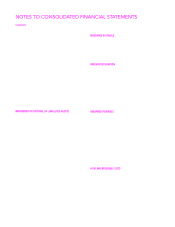Red Lobster 2015 Annual Report Download - page 38
Download and view the complete annual report
Please find page 38 of the 2015 Red Lobster annual report below. You can navigate through the pages in the report by either clicking on the pages listed below, or by using the keyword search tool below to find specific information within the annual report.
34
NOTES TO CONSOLIDATED FINANCIAL STATEMENTS
DARDEN
Changes in circumstances, existing at the measurement date or at other
times in the future, or in the numerous estimates associated with manage-
ment’s judgments and assumptions made in assessing the fair value of our
goodwill, could result in an impairment loss of a portion or all of our goodwill
or trademarks. If we recorded an impairment loss, our financial position and
results of operations would be adversely affected and our leverage ratio for
purposes of our credit agreement would increase. A leverage ratio exceeding
the maximum permitted under our credit agreement would be a default under
our credit agreement. At May 31, 2015, a write down of goodwill, other
indefinite-lived intangible assets, or any other assets in excess of approximately
$1.40 billion would have been required to cause our leverage ratio to exceed
the permitted maximum. As our leverage ratio is determined on a quarterly
basis and due to the seasonal nature of our business, a lesser amount of
impairment in future quarters could cause our leverage ratio to exceed the
permitted maximum.
We evaluate the useful lives of our other intangible assets, to determine
if they are definite or indefinite-lived. A determination on useful life requires
significant judgments and assumptions regarding the future effects of obsoles-
cence, demand, competition, other economic factors (such as the stability
of the industry, legislative action that results in an uncertain or changing
regulatory environment, and expected changes in distribution channels), the
level of required maintenance expenditures, and the expected lives of other
related groups of assets.
IMPAIRMENT OR DISPOSAL OF LONG-LIVED ASSETS
Land, buildings and equipment and certain other assets, including definite-lived
intangible assets, are reviewed for impairment whenever events or changes
in circumstances indicate that the carrying amount of an asset may not be
recoverable. Recoverability of assets to be held and used is measured by a
comparison of the carrying amount of the assets to the future undiscounted
net cash flows expected to be generated by the assets. Identifiable cash flows
are measured at the lowest level for which they are largely independent of the
cash flows of other groups of assets and liabilities, generally at the restaurant
level. If such assets are determined to be impaired, the impairment recognized
is measured by the amount by which the carrying amount of the assets exceeds
their fair value. Fair value is generally determined based on appraisals or sales
prices of comparable assets. Restaurant sites and certain other assets to be
disposed of are reported at the lower of their carrying amount or fair value,
less estimated costs to sell. Restaurant sites and certain other assets to be
disposed of are included in assets held for sale on our consolidated balance
sheets when certain criteria are met. These criteria include the requirement
that the likelihood of disposing of these assets within one year is probable.
Assets not meeting the “held for sale” criteria remain in land, buildings and
equipment until their disposal is probable within one year.
We account for exit or disposal activities, including restaurant closures,
in accordance with FASB Accounting Standards Codification (ASC) Topic 420,
Exit or Disposal Cost Obligations. Such costs include the cost of disposing of
the assets as well as other facility-related expenses from previously closed
restaurants. These costs are generally expensed as incurred. Additionally, at
the date we cease using a property under an operating lease, we record a
liability for the net present value of any remaining lease obligations, net of
estimated sublease income. Any subsequent adjustments to that liability
as a result of lease termination or changes in estimates of sublease income
are recorded in the period incurred. Upon disposal of the assets, primarily
land, associated with a closed restaurant, any gain or loss is recorded in
the same caption within our consolidated statements of earnings as the
original impairment.
INSURANCE ACCRUALS
Through the use of insurance program deductibles and self-insurance, we
retain a significant portion of expected losses under our workers’ compensation,
certain employee medical and general liability programs. However, we carry
insurance for individual workers’ compensation and general liability claims
that exceed $0.5 million. Accrued liabilities have been recorded based on our
estimates of the anticipated ultimate costs to settle all claims, both reported
and not yet reported.
REVENUE RECOGNITION
Sales, as presented in our consolidated statements of earnings, represents
food and beverage product sold and is presented net of discounts, coupons,
employee meals, and complimentary meals. Revenue from restaurant sales
is recognized when food and beverage products are sold. Sales taxes collected
from customers and remitted to governmental authorities are presented on a
net basis within sales in our consolidated statements of earnings.
Revenue from the sale of franchises is recognized as income when
substantially all of our material obligations under the franchise agreement
have been performed. Continuing royalties, which are a percentage of net
sales of franchised restaurants, are accrued as income when earned. Revenue
from the sale of consumer packaged goods includes ongoing royalty fees
based on a percentage of licensed retail product sales and is recognized
upon the sale of product by our licensed manufacturers to retail outlets.
UNEARNED REVENUES
Unearned revenues represent our liability for gift cards that have been sold
but not yet redeemed. We recognize sales from our gift cards when the gift
card is redeemed by the customer. Although there are no expiration dates or
dormancy fees for our gift cards, based on our analysis of our historical gift
card redemption patterns, we can reasonably estimate the amount of gift
cards for which redemption is remote, which is referred to as “breakage.” We
recognize breakage within sales for unused gift card amounts in proportion
to actual gift card redemptions, which is also referred to as the “redemption
recognition” method. The estimated value of gift cards expected to remain
unused is recognized over the expected period of redemption as the remaining
gift card values are redeemed, generally over a period of 10 years. Utilizing
this method, we estimate both the amount of breakage and the time period
of redemption. If actual redemption patterns vary from our estimates, actual
gift card breakage income may differ from the amounts recorded. We update
our estimates of our redemption period and our breakage rate periodically
and apply that rate to gift card redemptions.
FOOD AND BEVERAGE COSTS
Food and beverage costs include inventory, warehousing, related purchasing
and distribution costs and gains and losses on certain commodity derivative
contracts. Vendor allowances received in connection with the purchase of a
vendor’s products are recognized as a reduction of the related food and
beverage costs as earned. Advance payments are made by the vendors
based on estimates of volume to be purchased from the vendors and the
terms of the agreement. As we make purchases from the vendors each period,
we recognize the pro rata portion of allowances earned as a reduction of food
and beverage costs for that period. Differences between estimated and actual
purchases are settled in accordance with the terms of the agreements. Vendor
agreements are generally for a period of one year or more and payments
received are initially recorded as long-term liabilities. Amounts expected to
be earned within one year are recorded as current liabilities.





